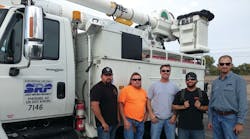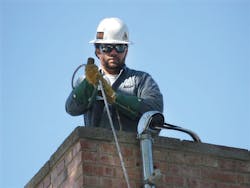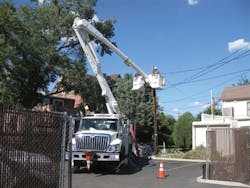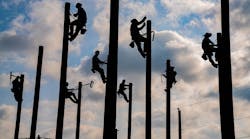Powerful winds, hail, lightning and flooding rains left close to 28,000 customers without power in Albuquerque, New Mexico, last summer. After experiencing one of the worst outages in 25 years, Public Service of New Mexico (PNM) called for help from five utilities in Texas, Arizona and New Mexico.
While PNM has provided mutual aid to other utilities, it was the first time the company had ever asked for help following a storm. Because the storm damage was so severe, however, PNM turned to neighboring utilities to provide additional resources and manpower.
For example, PNM called upon Salt River Project (SRP) in Arizona. As a member of the Western Regional Mutual Assistance (WRMA) Group, SRP has assisted utilities in New York, California, New Mexico and Arizona. As requested following the storm, SRP sent two two-person crews and an on-site supervisor to help out with the restoration.
Two days after the storm hit in New Mexico, more than 4,000 residents were still without power. After driving 10 hours to lend a hand, the SRP linemen spent two 16-hour days aiding in the restoration efforts. The SRP field crews first focused on providing service to a homeless shelter, which had been without power from a Friday to a Tuesday. This shelter housed 40 homeless people a night and fed about 400 a day. They then focused on repairing secondary services and conductors.
Lending a Helping Hand
In addition to helping PNM, SRP has come to the aid of many other companies through the WMRA agreement. More than 40 gas and electric utilities throughout the western United States and Canada have signed the agreement, which is facilitated by the Western Energy Institute.
Back in 2002, the California Utilities Emergency Association came to the realization during an Emergency Response Workshop that it needed to broaden the mutual-assistance agreement beyond the state of California. Several companies including Avista Corp.; Intermountain Gas Co.; NorthWestern Energy; NW Natural; Portland General Electric; Puget Sound Energy; Sierra Pacific Power/Nevada Power; Southern California Edison; Terasen Gas Inc.; and The Gas Company formed a task force and developed the WMRA agreement.
Eleven years later, the electric and gas companies are still actively helping each other following severe storms. As soon as utilities experience a catastrophic event on their system and realize they can’t man the work themselves, they often reach out to other members for mutual assistance.
In addition to coming to the aid of utilities in the western United States, SRP has also traveled to the East Coast to provide mutual assistance. Last November, Long Island Power Authority’s (LIPA’s) CEO called SRP’s general manager and asked him to send as many crews as possible following Hurricane Sandy. SRP ended up dispatching 62 linemen, electricians and heavy-duty mechanics to New York to relieve millions without power in the Northeast. Eleven crews worked for two weeks to erect poles, rerun services, reinstall primary wire and change out transformers. In addition, SRP sent 13 electricians to New York to clean and rebuild substation breakers and switchgear.
Getting Ready for the Storm
Before sending its crews to work a storm outside SRP’s service area, the utility must first line up the proper resources. When a severe storm strikes and a utility needs assistance, the company will call SRP and provide an overview of the damage. The executives then call upon the field managers to round up the necessary crew members, equipment and vehicles.
While SRP often sends journeymen to work out-of-town storms, on occasion, the utility also will send apprentices. The makeup of the crews depends on the workload of the linemen working on the SRP system. To keep major projects going forward, the utility works to keep the proper resources at home so they can support the other utility and take care of their own system.
Once SRP rounds up the work crews, then the managers conduct a briefing with the crews to tell them where they are going, what they will be doing and what they can expect to see when they get on site. That way, the linemen can share this information with their families so they know how long they plan to be away from home to work the storm-restoration effort.
After SRP decides which linemen will work the storm restoration, the fleet maintenance department then checks the vehicles to ensure they are ready to go out on the road. In most cases, the utilities that requested mutual assistance will reserve lodging and provide food for the out-of-town linemen, but in other cases, the SRP crews must do it on their own.
SRP linemen equip their bucket trucks with their necessary personal protective equipment and tools, and bring special tools and equipment that can help with the restoration effort. However, because every utility system is different in terms of voltages and connections, linemen often use the materials provided by the utility affected by the storm.
When the SRP crews arrive on site, the utility will conduct a safety meeting with all the contract and mutual-assistance crews. For example, in the case of the recent New Mexico microburst, the PNM safety team covered the safety rules and work practices unique to the utility. They also created a pamphlet for the out-of-town line crews to teach them how to stay safe during the restoration. Similarly, when in New York, the SRP crews learned about special crisis policies as well as LIPA’s system voltages, wire sizes and work practices.
After learning about the safety rules and procedures, the SRP team will remain on site as long as is necessary to help restore power to the majority of the customers. The utility in need will release the mutual-assistance crews first so they can return home to maintain their own system. Depending on the damage caused to the utility’s electric system, SRP linemen can be away from Arizona for days or even weeks.
By being a part of the mutual-assistance agreement, SRP is always ready to lend a hand when severe weather strikes. In return, other utilities are also standing by to help in case SRP needs assistance with restoring power and rebuilding infrastructure. Because the companies never know what severe storms are around the corner, they work together to improve their emergency response and restore power more quickly to their customers following a severe storm.
Matt Peek ([email protected]) is the section supervisor for the Salt River Project. He is responsible for managing the company’s transmission maintenance crews.




